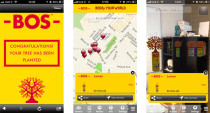Author Archives: repstein

“eTree” by Maurice Benayoun (2015)
Augmented Reality for Art is subject of a dynamically-generated piece of digital art, e-Tree (Emotional Tree), developed in CALLAS as a virtual tree whose growth and evolution reflects the perceived affective response of the spectators.

“eTree” by Maurice Benayoun (2015)
Augmented Reality for Art is subject of a dynamically-generated piece of digital art, e-Tree (Emotional Tree), developed in CALLAS as a virtual tree whose growth and evolution reflects the perceived affective response of the spectators.

“Bosify Your World” by Bos Tea (2014)
This is a company who’s QR codes allow you to place trees around the world

“Bosify Your World” by Bos Tea (2014)
This is a company who’s QR codes allow you to place trees around the world

“Blooms: Strobe-Animated Sculptures” by John Edmark (2015)
These sculptures look like a giant pile of ferrofluid which is pretty amazing. These 3-D printed sculptures, called blooms, are designed to animate when spun under a strobe light.

“Blooms: Strobe-Animated Sculptures” by John Edmark (2015)
These sculptures look like a giant pile of ferrofluid which is pretty amazing. These 3-D printed sculptures, called blooms, are designed to animate when spun under a strobe light.

“Virtualidades” by Josue Abraham (2014)
This exhibit combines virtual reality and the traditional medium that is sculpture.

“Virtualidades” by Josue Abraham (2014)
This exhibit combines virtual reality and the traditional medium that is sculpture.

“Ingress” by Niantic Labs (2015)
Ingress is an immersive, geo-location based AR game produced by Niantic Labs, a division of Google.

“Ingress” by Niantic Labs (2015)
Ingress is an immersive, geo-location based AR game produced by Niantic Labs, a division of Google.

“Perspective; Chapter 1: The Party” by Morris May and Rose Troche (2015)
This is the live-action story of a sexual assault at a frat party that viewers experience through the Oculus Rift virtual reality headset, from both a man’s and a woman’s points of view.

“Perspective; Chapter 1: The Party” by Morris May and Rose Troche (2015)
This is the live-action story of a sexual assault at a frat party that viewers experience through the Oculus Rift virtual reality headset, from both a man’s and a woman’s points of view.

“Abstraction” by Matteo Zamagni (2015)
This art project has you diving into 3D fractalsby using an Oculus Rift virtual reality headset and the imagery from Google’s neural network-based Deepdream.

“Abstraction” by Matteo Zamagni (2015)
This art project has you diving into 3D fractalsby using an Oculus Rift virtual reality headset and the imagery from Google’s neural network-based Deepdream.

“The Recorder VR” by Tim Goodwin/Tim Cragg (2015)
Tim Goodwin and his team made a VR piece in Collaboration with the photographer Tim Cragg. They used his still imagery and audio and augmented it to create a more immersive curated experience.

“The Recorder VR” by Tim Goodwin/Tim Cragg (2015)
Tim Goodwin and his team made a VR piece in Collaboration with the photographer Tim Cragg. They used his still imagery and audio and augmented it to create a more immersive curated experience.

“Water Effects” by Zach Rispoli, Becca Epstein, and Vivek Sangubhotla
We are playing with the manner in which the distortion of fluid affects projected imagery. We are in a phase of figuring out the technical mechanics. We hope to eventually use this technology to approximate the feeling of forgotten memory.

“Water Effects” by Zach Rispoli, Becca Epstein, and Vivek Sangubhotla
We are playing with the manner in which the distortion of fluid affects projected imagery. We are in a phase of figuring out the technical mechanics. We hope to eventually use this technology to approximate the feeling of forgotten memory.

“Karen” by Blast Theory (2015) Analysis
Karen is a phone app created by Blast Theory which plays with automatic reaction to trust and how big data uses this trust. Karen is a life couch who increasingly asks very personal questions. Karen is successful in that it extends theatre using fairly simple technology that’s already in our pocket.

“Karen” by Blast Theory (2015) Analysis
Karen is a phone app created by Blast Theory which plays with automatic reaction to trust and how big data uses this trust. Karen is a life couch who increasingly asks very personal questions. Karen is successful in that it extends theatre using fairly simple technology that’s already in our pocket.
